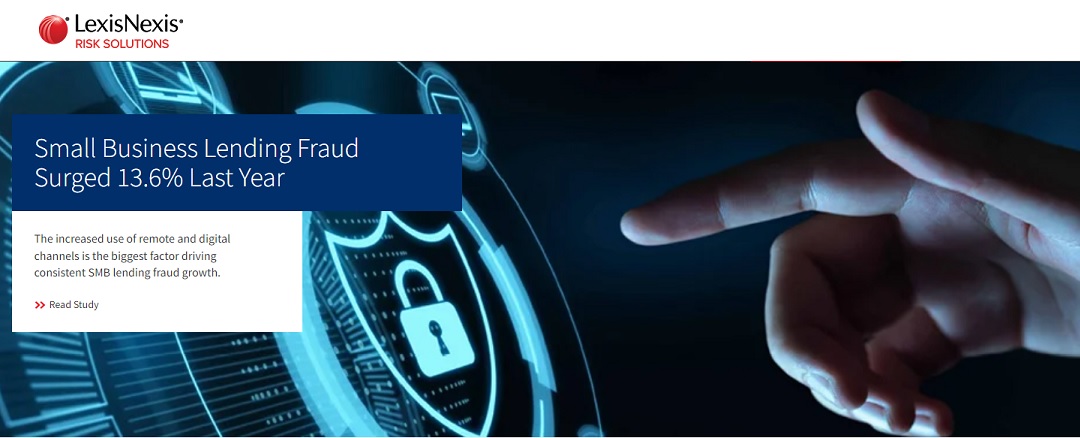
50% of respondents now believe SMB lending fraud can be prevented, compared to 31% in 2022.
Small and medium-sized business (SMB) lending fraud has increased by a double-digit percentage year over year, with most lenders expecting fraud levels to continue to increase in the coming months, as revealed by the latest edition of the LexisNexis® Risk Solutions Small and Midsize Business Lending Fraud Study. Overall, more than 80% of respondents said that SMB lending fraud has risen by nearly 14% over the last year, even as lenders are less willing to issue new credit.
SMB lending fraud is increasing at consistent rates but is gradually moving away from the influence of the pandemic. Notably, SMB lending fraud is typically caught within the first month of a new customer relationship.
Organizations recognize that reducing SMB lending fraud can lead to increased revenues and improved customer loyalty. With most fraud losses attributed to digital channels, 70% of organizations have adjusted their strategies for detecting and mitigating fraud. This shift highlights a proactive approach within the industry, with many lenders tightening their mobile and online transaction policies. While smaller banks and credit unions are balancing their policies, larger institutions are adopting stricter measures.
Key Findings on SMB Lending Fraud
| Rising fraud: SMB lending fraud grew by 13.6% year-over-year in 2023, with 64% of respondents anticipating further growth in the next 12 months. | |
| Detection challenges: While most fraud is identified within the first month of the customer relationship, only 27% of fraudsters were caught at account origination in 2023, down from 32% in 2022. | |
| Shifting perceptions: 50% of respondents now believe SMB lending fraud can be prevented, compared to 31% in 2022. | |
| Industry-wide impact: SMB lending fraud is a shared concern across industries, with most companies expecting it to impact overall losses by 6% to 10%. | |
| Increased investment: 72% of respondents plan to increase their investment in fraud prevention, reflecting the growing recognition of technology’s role in combating fraud. |
Top Methods of Fraudsters: In the period surveyed, stolen legitimate business identity and stolen consumer/owner identity have emerged as the most common type of SMB lending fraud, making detection particularly challenging. Recognizing that reducing SMB lending fraud can lead to increased revenues and improved customer loyalty, organizations are enhancing their detection capabilities. However, balancing fraud detection with minimizing customer friction remains a key concern.
Shift to Tech-Driven Fraud Prevention: There is an anticipated shift from labor-centric to tech-driven fraud prevention as companies face a recurring challenge in managing and mitigating fraud risks. SMB lending fraud is a shared concern across industries, with most companies anticipating overall losses between 6% and 10%. About 17% of these losses are due to efforts to reduce friction in approval processes.
Increase in Proactive Fraud Prevention: Businesses are enhancing their fraud prevention efforts by integrating advanced identity solutions like behavioral biometrics, geolocation and real-time transaction scoring to bolster their anti-fraud initiatives. Fintech/digital Lenders have shown remarkable improvement in this area.
“Though the perception exists that SMBs have complex structures, our annual study shows that lenders employing a multi-layered solutions approach, integrated with cybersecurity and digital channel operations, experience more positive outcomes when lending to small businesses,” said Tom Hunt, director, business risk strategy, LexisNexis Risk Solutions. “These include reduced fraud losses as a percentage of annual revenue and a slower rate of increase in SMB lending fraud.”
Top Four Recommendations for Preventing SMB Lending Fraud
Enhance Identity Proofing: Identity proofing encompasses both verification and authentication processes. While verification is a critical step, it may not be sufficient on its own to detect sophisticated fraud attempts. Authentication solutions offer a more dynamic and advanced approach to fraud detection and prevention, especially in remote channel applications where the risk of fraud is higher. Additionally, businesses need advanced fraud detection systems beyond manual methods. Utilizing technology is essential for effectively identifying and addressing fraud while minimizing inconvenience to customers.
Adopt a Multi-Layered Approach: Businesses should implement a multi-layered approach to authentication by combining different solutions to address unique risks from different channels, payment methods and products. This approach should integrate cybersecurity with fraud prevention efforts and employ advanced solutions like OTP/two-factor authentication, biometrics and behavioral biometrics.
Focus on Early-Stage Fraud Detection: New account opening is a crucial stage in the customer journey as well as fraud assessment at the point of origination. Maintaining robust screening solutions while managing the right amount of friction is key. This includes checks for fake or suspicious identification numbers, such as Social Security Numbers (SSN) and Tax Identification Numbers (TIN). A significant portion of fraud cases are identifiable and then prevented by enhancing the screening process.
Share Intelligence: Businesses should leverage the power of collective intelligence through consortiums and digital identity networks. By participating in a consortium, companies can share valuable data, creating a peer-based intelligence layer that allows them to gain greater context, secure their digital channels against cybercriminal networks and make smarter, real-time risk decisions.
Methodology
The study surveyed 135 individuals working at banks, credit unions, fintech/digital lenders and payment processors with responsibility for risk and fraud assessments or decisions for SMB customers. SMBs are businesses earning up to $10 million annually. The study set out to better understand SMB lending fraud, specifically its volume, how institutions identify and track fraud, the types of fraud experienced, what institutions are doing to combat fraud and whether there are differences in SMB lending fraud based on the size or type of organization.
Download the latest LexisNexis Risk Solutions Small and Mid-Sized Business (SMB) Lending Fraud Study.
Banking 4.0 – „how was the experience for you”
„To be honest I think that Sinaia, your conference, is much better then Davos.”
Many more interesting quotes in the video below: